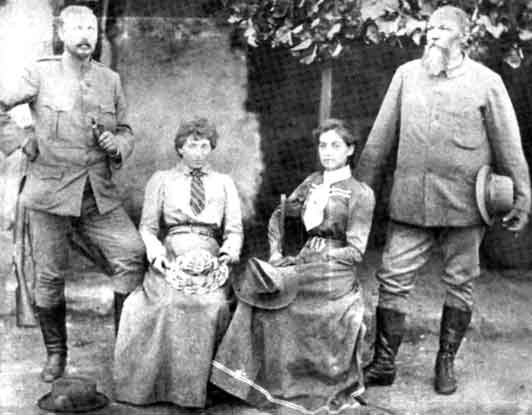
General Louis Botha, Mrs Botha, Mrs Meyer and the Boer-General Lukas Meyer
Source: Cape Archives
Back to home Back to Historical
The
Van Rensburg's of Rensburg Siding, Colesberg, Cape part
1
The Anglo-Boer War Introduction part 2
The Anglo-Boer War around
Rensburg Siding: Boer Leaders part 3
The Anglo-Boer War around
Rensburg Siding Nov 1899 part
4
The
Anglo-Boer War around Rensburg Siding Dec 1899 part
5
The
Anglo-Boer War around Rensburg Siding Jan 1900 part
6
The Anglo-Boer War around
Rensburg Siding Feb 1900 part 7
The
Anglo-Boer War in retrospect part
8
Australian units, persons and casualties part
9
MAIN
MAP source http://www.mjvn.co.za/anglo-boer/mainmap1.jpg
The Anglo-Boer War: Australians capture De Wet's artillery gun at Rensburgdrift part 10
Page 1 Page 2
An
Introduction to the Anglo-Boer War
Alwyn P. Smit
In 1899 the Anglo-Boer War, a war that was unwarranted, shameful in many ways and emanated from greed alone, broke out in South Africa. Before reading André van Rensburg’s account of specific encounters that took place at Colesburg, Arundel and Rensburg Siding, it would be appropiate to first familiarize oneself with some of the more important events that led up to this senseless war.
Condensed Historical Chronology of South Africa from 1652 to 1910
1652 Jan van Riebeeck establishes the first Dutch settlement; 1657 The first free burghers are allotted farmlands; 1688 The main group of Huguenot refugees arrives; 1781 A French fleet intervenes when Britain tries to annex the Cape; 1789 The French Revolution reaches its peak and The Netherlands is overrun by French forces, forcing Britain to send troops to the Cape; 1795 Dutch governor A.J. Sluysken and Admiral Elphinstone sign the Treaty of Rustenburg and the period until 1803 becomes known as the First British Occupation. The Republic of Swellendam and The Republic of Graaff-Reinet are declared; 1802 The Treaty of Amiens is signed by Lord Cornwallis and the Cape handed back to the Dutch; 1803 The Cape is ruled by the Batavian Republic and administered as a Dutch Colony under governor J.W. Janssens; 1806 The Battle of Blaauwberg results in the Second British Occupation and Lord Charles Somerset takes office as governor; 1813 Sir John Cradock makes British immigration possible; 1814 The Cape is officially ceded to Britain by the Netherlands; 1819 The boundary of the Cape Colony is moved eastward to the Keiskamma River; 1820 About 4500 British settlers arrive in Algoa Bay; 1835 The boundary of the Cape Colony is extended to the Kei River by Sir Benjamin D’Urban and the new territory is administered under martial law. Durban becomes the new name for Port Natal and the Louis Trichardt trek begins; 1836 The Great Trek starts from the eastern districts and gains momentum; 1839 The Republic of Natalia is declared; 1842 Boers besiege British troops under Captain Thomas Charlton Smith at Durban, but the handful of Boer trekkers are defeated at the battle of Congella; 1843 Most of the Boer trekkers leave Natal when it is proclaimed a British Colony by Sir George Napier; 1848 On 3rd February Sir Harry Smith declares the land between the Orange River and the Vaal River the Orange River Sovereignty, resulting in a battle between the Boers and the British at Boomplaats; 1852 The Zuid-Afrikaansche Republiek gains independence after the Sand River Convention; 1854 The Bloemfontein Convention is signed and J.P. Hoffman becomes the first president of the Orange Free State; 1857 The Vierkleur is accepted as the flag of the ZAR; 1864 Johannes Henricus Brand becomes the fourth president of the Republic of the Orange Free State; 1867 The first diamond is found near Hopetown; 1869 Diamonds are discovered near Kimberley; 1871 The Cape governor Sir Henry Barkly claims British Sovereignty over the diamond fields area; 1877 The ZAR is proclaimed British territory and is annexed by Lord Theophilus Shepstone; 1880 The First Anglo-Boer War; 1881 The ZAR regains independence under British suzerainty after British General Sir George Colley’s defeat at Majuba Hill on 27th February. After the Pretoria Convention the ZAR regains its independence; 1883 Stephanus Johannes Paulus (Paul) Kruger is elected as president of the ZAR, and the two Boer Republics of Stellaland and Goshen are founded; 1884 At the London Convention the ZAR is granted full independence; 1886 The rich Witwatersrand goldfields open and Johannesburg is founded. The Australians George Walker and George Harrison find gold at Langlaagte; 1889 A defence alliance is signed by the ZAR and the Orange Free State; 1890 Cecil John Rhodes, who made a fortune in diamonds at Kimberley, becomes Prime Minister of the Cape, with William Philip Schreiner acting as Attorney-general; 1895 The Jameson Raid is foiled by the Boers under Pieter Arnoldus Cronje; 1896 Marthinus Steyn is elected president of the OFS and the trial of those concerned in the Reform Movement and the Jameson Raid is held. Cecil John Rhodes, the diamond mining magnate and empire builder, resigns his leadership; 1898 William Schreiner becomes the new Prime Minister, and he is hopeful of bringing peace between the Boer Republics and Britain. Paul Kruger is elected President for a fourth term; 1899 The outbreak of the Second Anglo-Boer War; 1902 The Second Anglo-Boer War ends with the Treaty of Vereeniging on 31st May; 1905 Lord William Palmer Selborne succeeds Lord Alfred Milner as High Commissioner in South Africa, as well as Governor of the Transvaal and Orange River Colonies; 1910 The Union of South Africa is established on 31st May with the former Boer-leader Louis Botha as Prime Minister.

General Louis Botha, Mrs Botha, Mrs Meyer and the Boer-General Lukas Meyer
Source:
Cape Archives
The origins of and the reasons for the Anglo-Boer War 1899 – 1900
When Jan van Riebeeck established the first European settlement at the Cape it was intended to be a refreshment station for the Dutch East India Company. For various reasons however, considerable numbers of settlers arrived from The Netherlands, Germany, France and several other European countries. Circumstances had made these settlers disillusioned with the ruling powers of Europe and when they landed in the Cape they were already independence-loving separatists at heart. Over a period of time many of these non-conformists moved inland in search of land for farming. They worked hard, tamed the land and made it their own.
The relative peace and calm changed when the French Revolution broke out and in 1795 Britain was forced to send troops to protect the strategic Cape sea route against French influence. Several clashes between the English and the Dutch took place, and the Cape for the first time fell under British rule. After the signing of the Treaty of Amiens in 1802 this was reversed, but war broke out again between Britain and France. In 1806, after the battle of Blaauwberg (now known as Bloubergstrand), Britain once more took possession of the Cape.
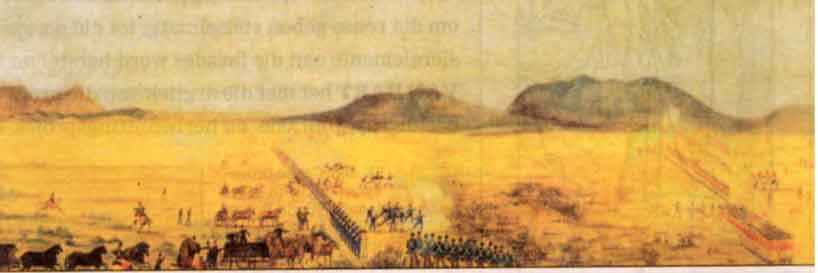
The battle of
Blaauwberg on 8 January 1806. The British with their redcoats under the command
of
General David Baird is on the right hand directly opposite Melkbos strand. On
the left hand J.W. Janssens
is in charge of the Dutch forces in their dark blue and brown uniforms. On the
right side towards
the rear is Blouberg and on the left side is a part of Table Mountain and Signal
hill.
Source: Die Burger taken from the William Fehr collection
A large proportion of the Cape settlers had no real issue with the British ruling the Cape, but with the Dutch-Afrikaners already deep in the interior of the country, it was different. In 1820 thousands of British immigrants arrived and the British Colonial government of the day forced their language and culture more and more upon the Dutch-Afrikaner farmers. Britain abolished slavery in 1834 and the farmers personally had to go to England to receive their compensation. As many farmers could only speak Dutch, and taking the high cost and inconvenience of a sea-trip into consideration, many farmers made use of agents to collect the money on their behalf. Unfortunately these agents charged so much for their services that most of the farmers eventually received very little in compensation. As a result of all these problems about 5000 disillutioned and republican-minded Boers and their servants started the Great Trek towards the regions which were later known as the Orange Free State, Transvaal and Natal.
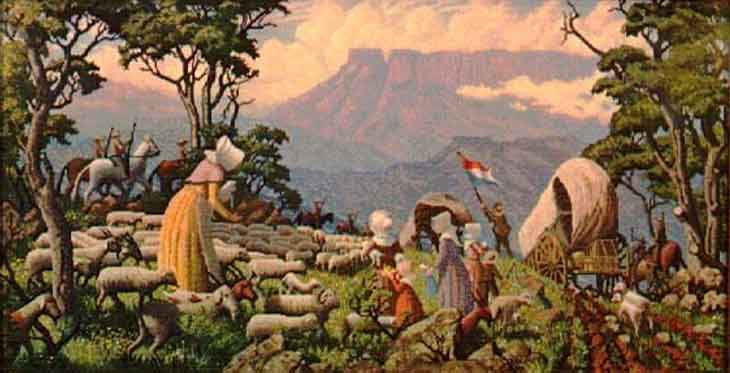
Tapestry of the Voortrekkers
In 1842 the British put an end to the Boer’s desire to establish an independent republic in Natal by defeating them at the battle of Congella. In 1848 this was followed by the proclamation of British sovereignty over the area between the Orange and Vaal rivers, naming it the Orange River Sovereignty. The last outpost, as far as the Boers (known as the Voortrekkers) were concerned, was now the area beyond the Vaal River, known as the Transvaal. In 1852 the British granted recognition of the South African Republic (Zuid-Afrikaansche Republiek) at the Sand River Convention. Two years later in 1854 the signing of the Bloemfontein Convention took place and this in turn lead the way to a free and independent Orange Free State Republic.
Some decades later momentous discoveries of immense mineral deposits were made, which would not only bring great prosperity to the Boer Republics, but also misery of such magnitude that it would change the history of the country forever. From Britain, covetous eyes looked south. When diamonds were discovered at Hopetown in the Orange Free State in 1867, and in 1869 at Kimberley, Britain took a different view of the developments in the northern hinterland. As the local Griquas under Hendrik Waterboer, the Orange Free State and the Zuid-Afrikaansche Republiek laid claim to the riches of the soil, the British in 1871 quickly brought the diamond fields under their rule.
The following year Cecil John Rhodes arrived at the minefields. After taking over his brother’s claims, he went into partnership with Charles Rudd, and in 1880 the two associates formed De Beers Diamond Mining Company. Rhodes became a close friend of Albert Beit, and through him he met the influential Lord Rothschild. Money was talking and clandestine politics made the future look grim for the two Boer Republics, now almost surrounded by land under British occupation and rule.
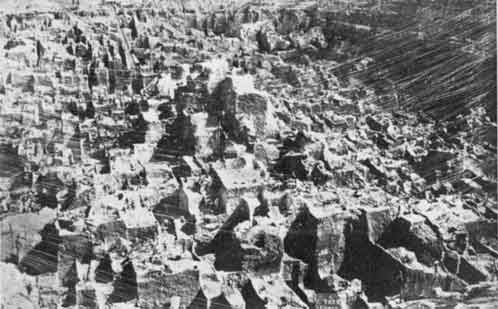
A photo from the early days of the famous Kimberley Hole
with cables extending down to the claims
Very soon all eyes, locally and abroad, turned towards the Zuid-Afrikaansche Republiek. The Secretary of State for the British Colonies in 1877, Lord Carnarvon, sent Sir Theophilus Shepstone to negotiate with president Thomas Francois Burgers. These negotiations ended in Shepstone taking over the administration of the area. Now that the British had made a mockery of the previous Sand River Convention, the republican-minded and independence-seeking Boers became more and more restless. Strong leaders such as Paul Kruger, Marthinus Pretorius and Piet Joubert came to the fore and in 1880 this resulted in the First Anglo-Boer War. The British were defeated at Majuba on 27th February 1881 and in August of the same year they decided to sign the Pretoria Convention. In 1883 the London Convention was signed and in 1884 Paul Kruger became the president of the already fully recognised independent Zuid-Afrikaansche Republiek.
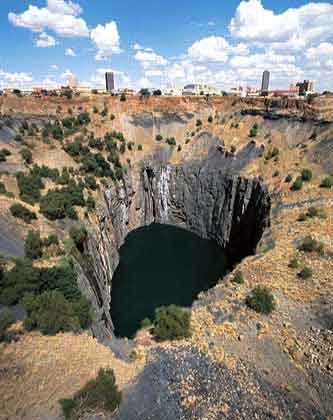
The Big Hole closed in 1914 and reached a depth of 1097.6 metres.
The mine had yielded more than 3 tonnes or 14 504 375 carats of diamonds
and was once the biggest man-made crater in the world